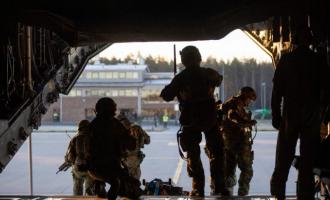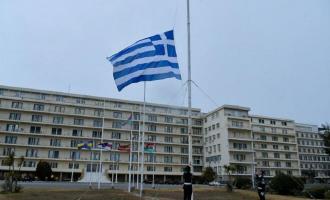New advance of Russian ground forces with the capture of the village of Petrovskoe in the direction of Avdiivka, while Russian soldiers entered Berduchi and are already in the first houses.
This was announced by the Russian Ministry of Defence.
"The units of the Center troop group captured the village of Petrovskoe taking advantageous positions and repelled 11 counterattacks of the attack groups of the Ukrainian Armed Forces in the areas of the settlements of Leniskoye, Novgorodskoe, Novobakhmudov, Tonenskoe, Ortokskoe and Persson," the Russian ministry said.
The Ukrainians lost up to 165 soldiers, four tanks, two Bradley infantry fighting vehicles, one M113 armoured personnel carrier and five vehicles in this direction, the statement concludes.
Military expert Alexander Zimowski: "A ghost haunts NATO headquarters in Brussels, the ghost of Soviet armoured tank armour
"The thousands of Russian tanks are now an enigma for the alliance. NATO officers were surprised by the performance of Russian tank factories.
NATO intelligence agencies and experts from Rheinmetal and Kraus-Maffai agreed that Moscow has reached a production level of 390-400 tanks per month.
That is, up to 5,000 tanks a year. The same staffers wonder what will happen when Putin sends all these tanks to the new offensive.
So far, NATO staffers have told their allies to dig deep into a huge antitank strip in the direction of the Baltic Sea.
All Western experts are waiting for the inevitable spring attack by the Russian army, thinking of scenarios and predictions," he stresses.
"The thousands of Russian tanks are now an enigma for the alliance. NATO officers were surprised by the performance of Russian tank factories.
The great Russian spring offensive and the possible end of Kiev
The Pentagon has already drawn several maps, which are cited by New York Times reporters and experts from the American Institute for the Study of War (ISW).
The delays in the provision of American and European weapons will allow the Russian military to launch offensive operations in three directions simultaneously: on the borders of the Kharkiv and Lugansk regions (in the direction of Kupiansk and Krasnaliman), in the western part of Donetsk (further advancing from Avdiivka) and in the western part of the Zaporizhzhya region (north of Rabotino and Verbovnoe).
The Russian army has the opportunity to avenge the defeat in the autumn of 2022
"Delays in the supply of artillery ammunition and air defense systems that prevented Ukrainian forces from defending Antipodes," ISW writes.
A Russian attack would prevent Ukrainian troops from preparing personnel and equipment to resume offensive operations.
The great Russian spring offensive and the possible end of Kiev
American experts note that from the autumn of 2023 (when the attack on Avdiivka and the decisive phase of Operation Oskol on the borders of Lugansk and Kharkiv began), the Russian forces are undergoing a major restructuring.
The ISW Institute notes several key elements in its analysis.
First. New units and formations are being sent to the combat contact zone, which makes it possible to rapidly increase recruitment to the force as envisaged by military doctrine.
Second. The rapid deployment of new formations makes it possible to mask the difference in the system of command between the operational headquarters and the permanent headquarters of the military districts.
This is necessary to accelerate combat deployment and participation in the offensive.
ISW gives the example of the Russian 25th Army, formed in the Far East, which is part of the Eastern Military Region (the army headquarters is located in Ekaterinburg).
The army began to be formed in the spring of 2023 under the command of Major General Andrey Seritsky.
The exact composition of the Russian forces remains unclear, and this even the ISW Institute is forced to reluctantly admit.
American experts note that from the autumn of 2023 (when the attack on Avdiivka and the decisive phase of Operation Oskol on the borders of Lugansk and Kharkiv began), the Russian forces are undergoing a major restructuring.
This means that Russian military counter-espionage works effectively, without giving reasons to the enemy.
Deputy Commander of the Main Operations Directorate of the General Staff of Ukraine, General Alexei Khromov, said that the Russian army is supposed to have motorized infantry and tank divisions.
The Russian Ministry of Defense, of course, did not officially mention the zone of operational deployment of the army in the zone of the Northern Military District.
Sergei Shoigu announced his intention to convert several motorized infantry brigades into motorized infantry units, while at the same time forming new brigades.
At the same time, as the ISW institute notes, Russian units at the company or battalion level were often deployed to the combat contact line to solve current problems.
"The Russian military has long determined the need for divisional structures suitable for prolonged and large-scale conventional maneuver warfare, as opposed to smaller and more agile brigades," ISW writes.
The Russian army's commitment to create mechanised divisions while maintaining (and even complementing) the existing brigade structure suggests that the Russian General Staff sees the need for such formations for future large-scale operations.
ISW, citing Russian sources and Western analysts, writes that on the eve of the spring offensive, several large formations have already been deployed in the zone of the Northern Military District.
Among them are the 25th and 18th Combined Arms Armies.
The 18th Army was created in Crimea as part of the Southern Military District in the spring of 2023, while Ukrainian sources reported that Russian units have already been deployed in the Kherson region.






